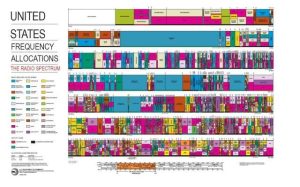Šta bitka AI spektra znači za 5G?

Danas, most readers may already understand the importance of spectrum to 5G, and the way the spectrum is obtained is relatively straightforward, either auction auctions or national distribution licenses. Nowadays, the “grab land” competition of spectrum resources in various countries has already come to an end, and operators are faced with high construction costs. The most urgent task is how to improve the utilization of the spectrum.

Među njima, spectrum sharing is regarded as a key way to end the spectrum scarcity. But in the process of time, there are many problems that cannot be ignored. And how will AI affect the footsteps of 5G into reality?
Where is the spectrum sharing difficult?
To put it simply, the different types of networks can release some of the spectrum resources according to their own business conditions and use them together with other networks. Na primjer, in the early 5G, if you want to split a part of the original 4G spectrum into 5G, it will directly reduce the available spectrum of 4G, and there are not so many 5G terminals. The large probability of allocating the past spectrum is also a waste.
In fact, as early as 2017, 3GPP accelerated the 5G standard, and also introduced 5G NR spectrum sharing research, which included spectrum sharing as an integral part of the 5G standard. But today, spectrum sharing has not been widely promoted.

The first is a technical challenge. Spectrum sharing means that two wireless communication networks share a common frequency band, but compatibility problems between channels are easy to occur.
Na primjer, 4G is a broadband system, the channel configuration is relatively extensive, and 5G is also a broadband system. There are also various physical channels. To prevent interference between physical channels between the two systems, it is necessary to propose very precise “traffic rules” to avoid “Crash.”
U isto vrijeme, more and more coexisting network standards have further increased the difficulty of sharing. In addition to the existing 2G/3G/4G/5G, itd., satellite Internet and military systems are also expanding.
As early as 2015, the Federal Communications Commission (FCC) released the CBRS band with a bandwidth of 150MHz, allowing other users to use it to alleviate the pressure of scarce spectrum resources and increasing congestion. kako god, network degradation such as 2G/3G is not something that can be done overnight. Tokom ovog perioda, how to coordinate the 5G construction with the spectrum supply and demand has become a necessary condition for operators to survive.
After 5G has completed a series of basic preparations, it is time to come to the middle layer of the industry chain, and really think about how to improve operational efficiency, and then achieve double insurance for user experience and business benefits.In our view, a comprehensive AI algorithm can be the most critical existence to support the 5G network and the real world. At least in spectrum sharing, AI can play three key roles:

The second is intelligent scheduling. The situation of multi-system coexistence is also making the peak change of hotspots of network traffic more difficult to predict. The intelligent algorithm can re-adjust the system capacity between 4G and 5G according to the actual traffic demand so that the 5G solution of hybrid networking can be solved. All equipment in the solution can maintain optimal performance from time to time.
Na primjer, Huawei’s CloudAIR solution, Ericsson’s spectrum sharing software, uses an intelligent scheduling algorithm to achieve the feasibility of 4G and 5G running simultaneously and on-demand on the same carrier frequency.

The third is efficient deployment. The final competition of 5G operators is still in business innovation. kako god, the requirements of different types of services for network indicators vary widely. The gradual access of massive IoT also puts higher requirements on the carrying capacity of operators. To support diversified business needs and rapid application development, and to get the return of investment income from users as soon as possible, it is crucial to help users get the best experience of 5G by quickly releasing applications with the efficient deployment capability of AI.
All in all, in this battle for 5G spectrum, the use of AI to achieve refined management, this proposition is waiting for the top design, operators, infrastructure suppliers, developers and other practitioners to work together to build.
It is not easy to do an improved operation on a communication system carrying billions of netizens. kako god, the problem also means opportunity.Who can take the lead in this spectrum-sharing technology capture game, it is clear that the first batch of gold mines of the 5G revolution will be unearthed by the role of “waterman”.Trenutno, it seems that the opportunities are more likely to emerge in the field, one is the cloud network infrastructure.
Since the service requirements of different operators are inconsistent in time, space, and frequency, it is necessary to establish a shared interface between multiple operators’ spectrums to exchange information and negotiate spectrum sharing rules, but operate in a competitive relationship. Between merchants will not be willing to interact with more detailed sensitive information, then how to regulate spectrum resources based on fuzzy information? Today we know that many AI functions have been integrated into the cloud, and the core online cloud can achieve multi-dimensional integration of operators’ air interface resources, which has become the trend of the times.

The other is the generalized Internet of Things across terminals.
As we all know, in the intelligent transformation of industrial Internet and car networking, it is necessary to establish a stable connection between multi-network systems and multi-terminals. It can be said that it is the outpost of 5G applications and the experimental field of spectrum sharing. Trenutno, the policy has already planned to allocate some new frequency bands to support its development. U isto vrijeme, under the premise of ensuring no radio interference, the three operators are also using the existing network to carry out the NB-IoT (narrowband Internet of Things) test. Future broadband system frequency sharing and management methods may be the first to be born in this field, and the industry itself has the opportunity to taste the 5G sweetness first.
The battle for spectrum may also extend to the more distant 6G construction. While spectrum sharing really comes to reality from the technical blueprint, the support of the AI industry is indispensable. And we are also in the trajectory of the city’s smart upgrade step by step, and gradually see the direction.


